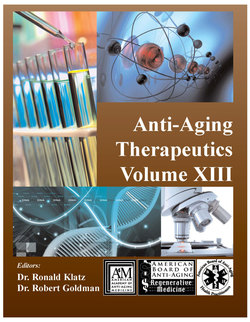Читать книгу Anti-Aging Therapeutics Volume XIII - A4M American Academy - Страница 52
На сайте Литреса книга снята с продажи.
Resveratrol as a Phytoestrogen
ОглавлениеA dose-dependent relationship exists between wine consumption and bone density. Given the significant morbidity from osteoporosis with age, this translates to a benefit in terms of both quality of life and mortality. Here again resveratrol provides a plausible cause-effect relationship, as an ER agonist with high degree of affinity.18 Hormone replacement therapy for post-menopausal women remains highly controversial, so phytoestrogens may provide an alternative if they can be proven selective and effective.
Estrogen receptors exist in many tissues throughout the body, including brain, kidney, heart, vascular endothelium, prostate, and bone, in addition to breast, ovary, and endometrium. They are broadly divided into 2 types, though many isoforms exist within each category, and receptor binding produces different effects from different agonists. For example, tamoxifen is an ER antagonist in breast tissue but an agonist in bone and endometrium. Furthermore, any given molecule may act as both a transcriptional co-activator and co-repressor within the same tissue, depending on dose and homeostatic compensation. This results in a considerable challenge in identifying all of the actions of a given ER modulator, and the various effects of phytoestrogens are incompletely known.
Resveratrol has been shown to be an ER agonist in vascular endothelium, and release of the vasodilator NO may be driven by this interaction. This may mimic the role of endogenous estrogen in protecting against atherosclerosis. Resveratrol also stimulates ER’s in bone, resulting in up-regulation of bone morphogenic proteins. A more complex picture characterizes the interactions of resveratrol and ER’s in breast tissue. Though it has a strong binding affinity, there is evidence that resveratrol may block the formation of estrogen-DNA adducts and estrogen-induced cell transformation at multiple sites, independent of its other anti-tumor actions. Additionally, resveratrol appears to reverse the epigenetic silencing of BRCA-1, a tumor suppressor involved in DNA repair, which is down-regulated in some types of breast cancer. This effect is mediated via the aromatic hydrocarbon receptor (AhR), in parallel with reduced occupancy of the alpha type ER. On balance then, the role of resveratrol appears protective but not thoroughly understood.
Figure 3. Diethylstilbestrol
A cursory look at ER agonists reveals a common ligand shared by resveratrol and other phytoestrogens. Among the most similar to resveratrol is the synthetic estrogen diethylstilbestrol, or DES. This was widely prescribed for estrogen replacement in the mid-twentieth century, and eventually withdrawn from the market when it was found to be associated with clear cell vaginal and cervical adenocarcinoma in adult offspring of women who were took it during pregnancy. Additionally, the mothers were found to be at increased risk for breast cancer. Given the several decades that it took to discover these problems, caution must be observed with the use of similar compounds especially for pregnant women. The use of phytoestrogens in men has not been well studied and should also be viewed with prudence.
